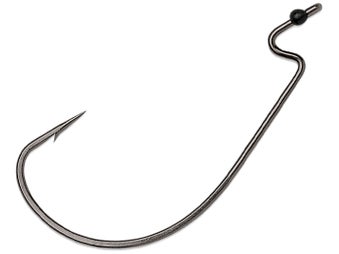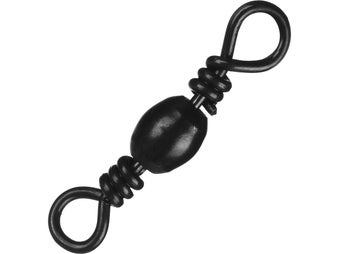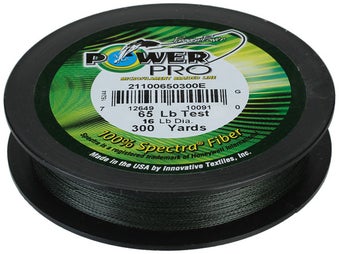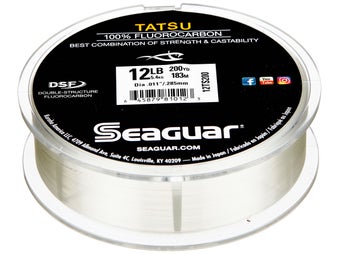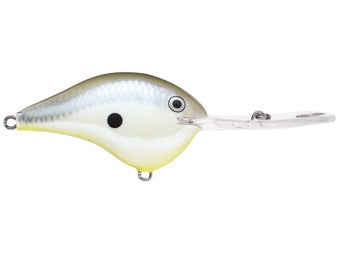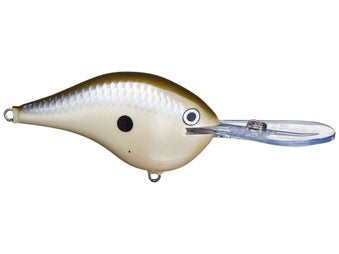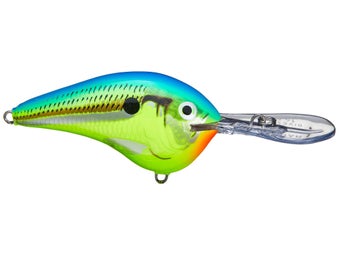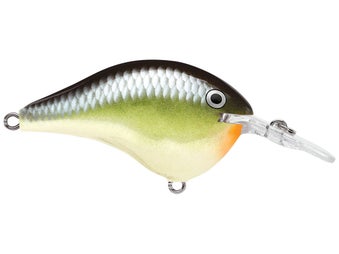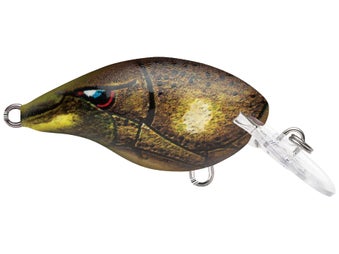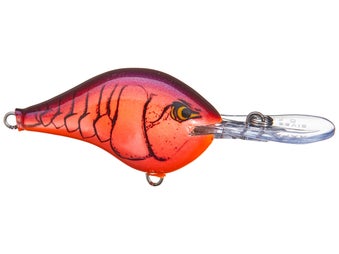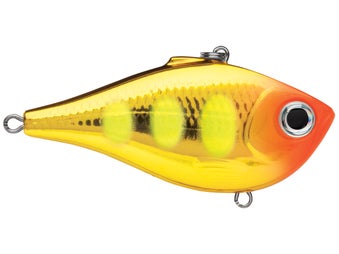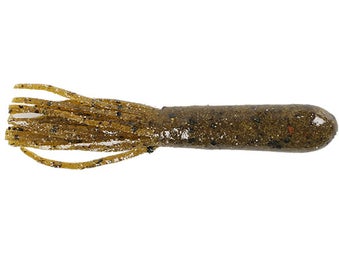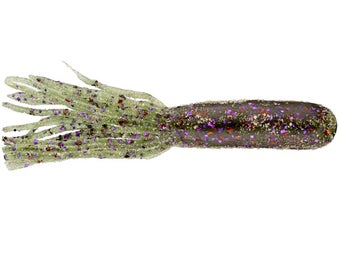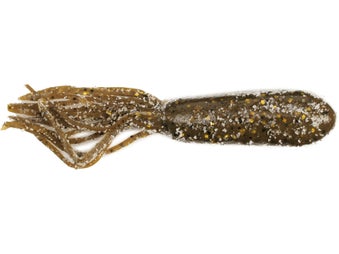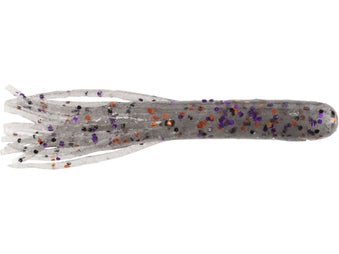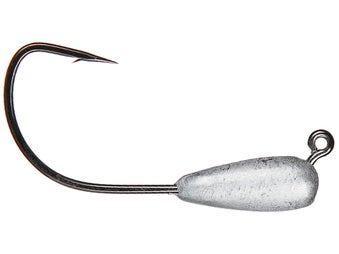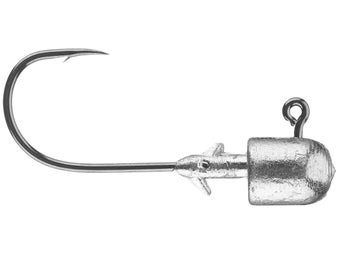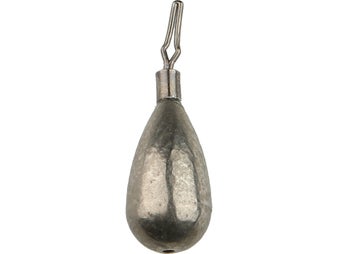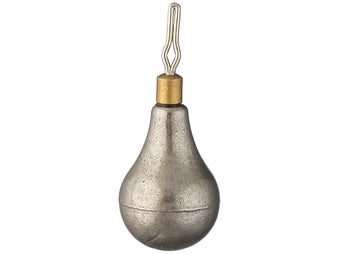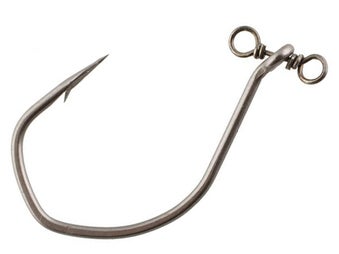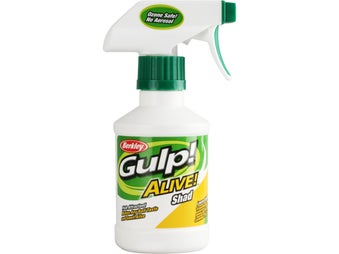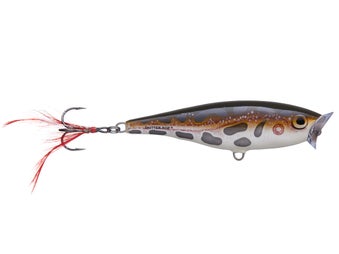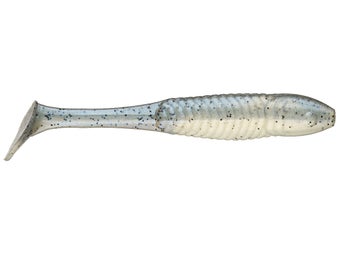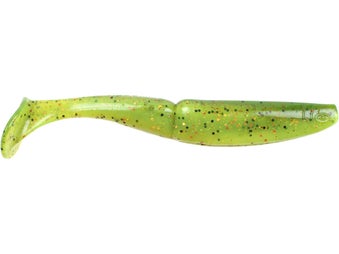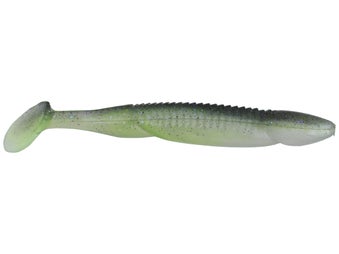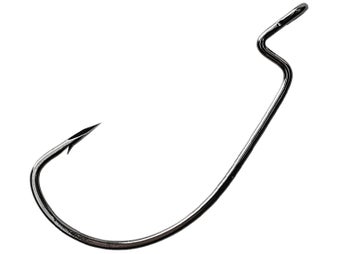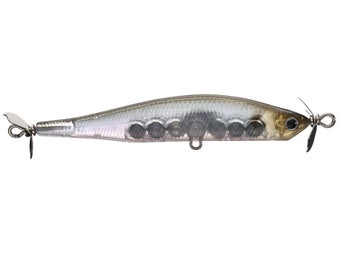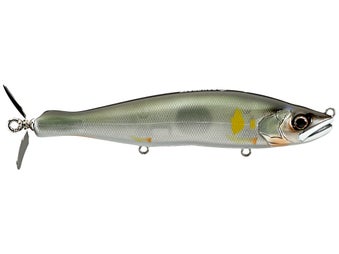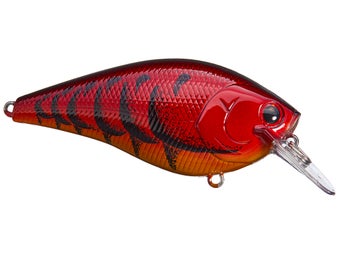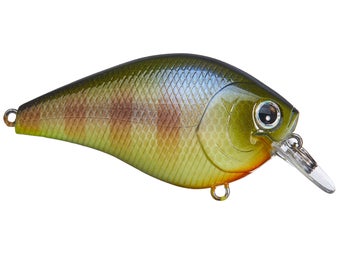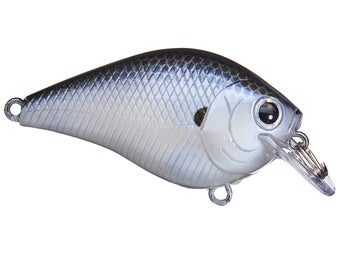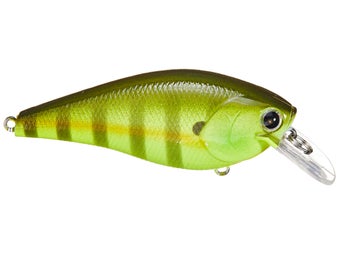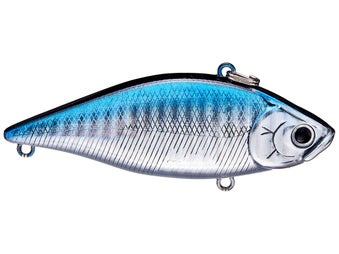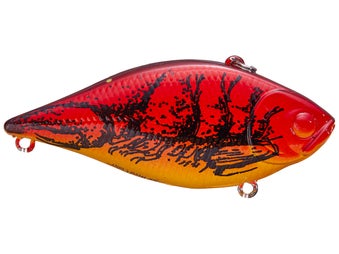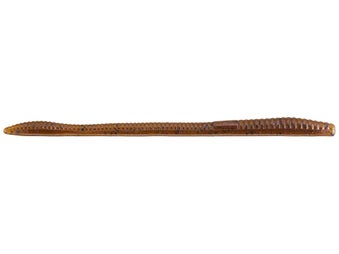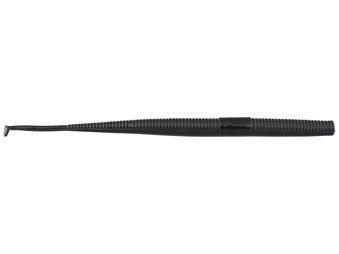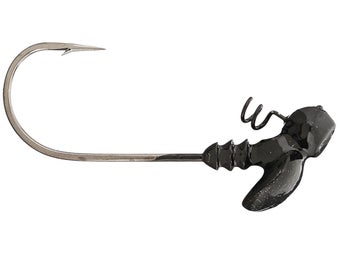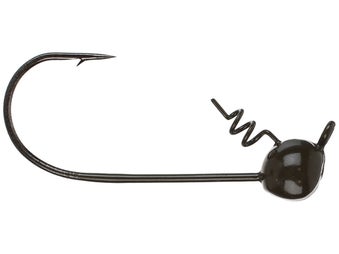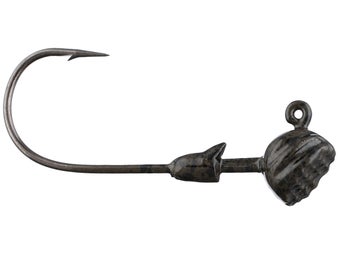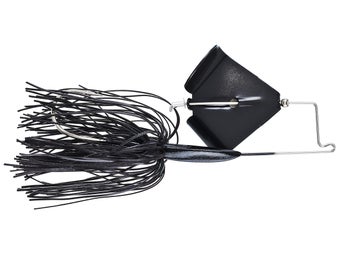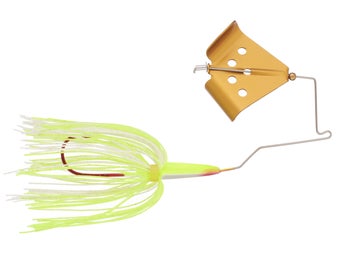Pro's Picks For Fall Bassin'
Mike Iaconelli - A Match The Hatch Fail
Think Pink:
"Think about a huge ball of bait (thousands of shad) in the back of a creek with a fresh run-in. It gets so easy for the bass to pick 'em off. Then, you throw in a crankbait. Your lure just gets lost in the crowd OR it just doesn't exactly mimic the forage by its appearance and movement, so they just don't bite." Ike reported that in this fall challenge, often the best way to provoke the fish to bite is to go in the opposite direction of trying to match the hatch. When he goes outta- the box in this "freaky fall" situation, he thinks polar opposite of the bait. He thinks "shock color" and picks a lure that is bright, obtrusive and ugly. "I want something with a color that doesn't look like anything that they are around," he added. "I will use a spinnerbait, crankbait, a jerkbait and one of my favorite lures for this... a soft jerkbait. It looks different, it attracts them with action, it covers a lot of water and it fishes at different levels."
His choice is his own signature soft jerkbait designed for Berkley Havoc - the Jerk in the color Pinky. "It is almost a bubble gum pink," he said."When the fish are feeding on those zillions of three inch shad and all of a sudden this pink thing comes moving through there with this amazing twitching action when its swimming and shimming when it sits, it looks so different then what is around them, it becomes their target. It deviates from everything they are seeing. It stands out from the crowd. It doesn't match the hatch." The 2003 Bassmaster Classic champ has found the Pinky Jerk to be effective in these fall feeding situations with smallies and spotted bass. "It is not just for largemouth," he added.
Location & Presentation:
He focuses on making extra long casts past the target. His target may be the baitball that he has located, any specific forage that is visible, a piece of cover, a dark spot on a shoal or flat etc. He then twitches the fluke-style lure toward the target, using a jerkbait type of retrieve. "Maybe two to four twitches real hard to make it walk and dance and then a pause," he said. "I ALWAYS follow the twitches with a pause and my average pause is three to five seconds." He stressed the importance of the pause in the retrieve and confirmed that approximately 75 percent of his strikes came on that pause. "I like to give the analogy that something is being chased and while it is trying to get away, it stops and turns around to look behind it to see if anything is still coming - that is the pause," he said. "When I do pause, I let it fall on a semi-slack line and the Jerk will shimmy on the fall and that is what gets that reaction strike."
Jerk Gear:
He fishes his Jerk with a long spinning rod, opting for the 7'6" Veracity with 10 or15 lb Spiderwire Fluoro-Braid. "Instead of tying directly to the braid, I use a no. 6 or no. 8 barrel swivel and a12 to 24 inch leader of 8 to 12 lb Berkley Trilene 100 % Fluorocarbon," he stated. "The leader with a swivel is really important, especially in clear water situations." He chooses the size of his fluorocarbon depending on the water clarity. In less cover and clear water, he goes for the 8 lb. With a moderate amount of cover and semi clear water, he will go for the 10 lb and in dirtier, stained water with heavier cover such as lily pads or wood he will go to the 12. He adds the swivel because it increases the bait's weight to assist in longer casts, it helps with line-twist and it has flash that can give the appearance of a little piece of bait being chased by the "big pink thing" behind it. "I've seen it more times than not, the guy throwing the swivel gets more bites than the guy without it, even though the rest of the setup is the same," he said. He uses a 4/0 VMC Extra Wide Gap hook. "A fluke style bait is a little thicker, so I want that hook to compensate for the extra girth," said Ike. "I Texas-rig it, even in a situation where there is no cover at all, in open water, I am still going to Texas-rig it, but I pop the hook out or Texpose it. When I am in cover, I keep the hookpoint embedded in the body."
Click Link To Shop: Bass Angler Magazine
A Match The Hatch Fail Fall 2014 Bass Angler Magazine (Jody Only pg. 34-35)
Cody Meyer - Back To The Sweet Spot
Location:
He locates schools of spots by finding baitfish. "That time of year, the trout will come up shallow, there will be shad and pond smelt in the mix," he explained. "All of the fish seem to come together at this time of year. I want to find bait busting the surface." It is Meyer's favorite time of year to locate spots using his electronics. "You can really see them on the graph and you get to fish big concentrations of them," he said. "Typically, once you find them in a certain depth, because of the thermocline, they're going to be around that depth zone. If you remember that, it can save you a lot of time idling around." Meyer noted that after a couple of catches, he can determine the size of fish in the school. He then can decide whether or not he wants to target this class of fish or move on to a different school in search of a larger bite. As a rule of thumb, in the early fall, he tends to target main lake points and in the later part of the fall, he moves to the backs of creeks.
Lure Selection & Gear:
For early mornings and low light conditions, Meyer begins with a topwater bait. "I'm still looking for those schooling fish," he said. "First thing in the morning, you can visually see them busting bait on the surface. That is a great thing about a topwater lure - they will come up from the deep, even out of the 30 ft of water to eat it." His topwater picks are a Jackall Bowstick and a Jackall SK Pop. He fishes his topwater lures on a 7' Shimano Crucial medium-heavy crankbait rod with 15 lb braided line. "Sometimes I will add a 15 lb monofilament leader with an Albright knot," said Meyer.
Later in the day, as the sun comes up, Meyer focuses more on his electronics looking for the bait and using a lure that will get deep. " You could find them on a flat, in the back of a creek, a point, or anywhere that you graph schooling fish," he said. "Once, you find them on the fish finder, you can use a dropshot to drop down on them and 'video game' fish. There is really no wrong time to fish a drop shot. You can fish it from first cast to last cast." His dropshot rig includes a natural colored Jackall Cross Tail Shad, Gamakatsu dropshot hook and 3/16 to 1/4 oz River2Sea Tungsten dropshot weight. He fishes this rig on a 7'2" medium-light Shimano Cumara dropshot rod spooled with 10 lb Power Pro braided line with a 6 lb Seaguar fluorocarbon leader. He works it by throwing out and dragging it along the bottom. "I really just visualize the dropshot rig staying in contact with the ground, moving over every single rock," he stated. There are times when he will hop the bait. "That is when you are looking for more of a reaction strike," he stated. "It seems that I get more fish just dragging it and fewer bites hopping it, but that is where a bigger bite will usually come in."
Meyer also feels the jig is a must-have lure for the fall to mimic a crawdad. "As the water cools, the fish get more active and they feed them," he said. He prefers a 3/8 to 3/4 oz football head G-Money jig with a trailer that matches the hatch. The jig size depends on the depth of water he is fishing. The deeper the water, the heavier the jig. He throws the jig in the same areas that he does his drop shot rig. He fishes his G-Money on a 7'2" medium heavy Shimano Cumara casting rod with a high gear ratio Shimano casting reel. "I use a 10 to 15 lb fluorocarbon, choosing the lightest line that I can get away with depending on the structure," he said.
Click Link To Shop: Bass Angler Magazine
Back To The Sweet Spot Fall 2014 Bass Angler Magazine (Jody Only pg. 82-83)
Davy Hite - Fall Got You Feeling Cranky
Location:
Hite mainly considers two factors when deciding to make the move to shallow water. "I think the length of the days has an effect on the fish," he begins. "Once those days start getting shorter and shorter and that water temperature starts dropping, that's when I transition into what I call a fall pattern." The pro adds that the timing of this transition depends on what part of the country is in discussion. "It could be late August or early September in the north and as late as October in the south," he says. Hite says he tries to move with the fish and first targets main lake structure close to a creek or bay. "Points, pockets and creek channels that come close to the main channel are my first stops," he says. "After that, I gradually move back into the creek as the fall progresses." He also considers baitfish migrations as part of the equation. "When the shad or predominant baitfish start to migrate, the bass will follow." While he fishes assorted types of cover, Hite does have a favorite. "In the lakes that have vegetation such as hydrilla, elodea, or milfoil, and when that vegetation sits in that 5 - 10 foot depth range, I'm going to start there," he says. "On lakes with no vegetation, I like standing timber, boat docks, or shoreline vegetation like lily pads and pepper grass," he continues. "The patterns could involve a variety of things, but if there's vegetation present, then that's the first cover I'm going to target."
Lure Selection:
Hite points out that many anglers select a particular crankbait for the wrong reason. "We all like pretty baits, or baits that look natural, or have a great custom paint job, but the first thing to consider is that you need to tie on baits that run different depths," he explains. "When you go out on any given day in the fall of the year, the fish can be anywhere from 1-2 feet deep all the way down to 10-12 feet deep." Hite advises anglers to also have at least three different types of crankbaits on deck. "I'm going to have a shallow squarebill, a 5-6 foot bait like a Rapala DT6, and I'm going to have a 10 foot bait like the Rapala DT10," he says. "I see so many people go out to pre-fish or practice, not knowing what depth range the fish are in and have crankbaits tied on that all run the same depth," he points out. "It's just so important to have a variety of baits that can cover different parts of the water column."
For his fall fishing, Hite narrows his colors to mimic baitfish. "I consider the size of the predominant baitfish and I narrow my colors to shad, herring, alewife, or whatever baitfish that are prevalent in the lake or river system I'm fishing," he advises. "In the spring of the year I fish the oranges and reds which are crawfish colors, but in the fall I stick to baitfish patterns," he says. Hite also adds that water clarity comes into play when selecting colors. "In the fall of the year you tend to have more dark, and tannic water than you do muddy water," he reveals. "If that bait isn't showing up as much as I like, I'll pick a bait with some chartreuse in it." For highland lakes and sunny days, Hite goes a different direction. "If the lake is clear and there's some sun, I like a bait that's got chrome," he discloses. "I really like that flash in the fall of the year." Hite also likes to vary other factors such as vibration and retrieve. "I will have a couple of baits that have a wide wobble and move a lot of water, and some that have a little less," he says. "But, in the fall of the year I usually want a bait that's thumping quite a bit." Hite goes on to recommend squarebills for the most vibration and the Rapala DT Series for a little less throb.
Lipless crankbaits are also a big part of Hite's playbook and he keeps one tied on virtually all year long. "The cool thing about a lipless bait is its versatility," he praises. "You can fish the entire water column, letting it sink to the bottom and yo-yoing the bait or you can burn it in shallow water 2 feet under the surface." Hite's go-to lipless crankbait is a Rapala Rattlin' Rap which he especially likes to fish around vegetation.
Lure Presentation:
As one would expect, the type of cover being fished has a great influence on which bait Hite picks. "The DT6 and DT10 really come across rock and wood well, and will also come through vegetation," he says. "The DT6 is my favorite shallow water grass bait." Hite stresses the importance of having baits that the angler can be confident with around cover. "I think a lot of people have trouble becoming a good crankbait fisherman because they get their baits hung and they often lose them," he continues. "To be successful that bait has to go where the fish actually live and that's going to be around cover." Adding to the difficulties, Hite also stresses the importance of the crankbait contacting cover. "You really do need to occasionally run into the cover you are fishing, be it rock, wood or vegetation," he adds. Hite simplifies the science of retrieves into a trio of basic categories. "Really, there's three retrieves with a regular lipped crankbait and that's fast, slow, or stop and go," he says. "As far as the lipless baits, you have a fast, slow and my stop and go with a lipless bait is more of an up and down motion, causing the lure to stop and fall."
Cranking Gear:
Hite keeps things simple when constructing his rod and reel set up for cranking. "The only thing I vary is the line size and the rod length," he says. "For most of my crankbait fishing I use a 7' All Star medium action crankbait rod with a Pfleuger Patriarch Reel spooled with 10-20 pound Berkley Trilene Professional Grade 100% Fluorocarbon line." Hite does occasionally vary the rod length in tight quarters. "If I'm making casts to isolated, specific targets where accuracy is more important than distance, I scale down to a 6' 6" foot rod," he reveals. "And, if I'm fishing something like heavy timber and I need to move a fish out of there I'll go to heavier line."
Click Link To Shop: Bass Angler Magazine
Fall Got You Feeling Cranky? Fall 2014 Bass Angler Magazine (Rob Bryant pg. 44-47)
Draggin' For Fall Smallies
Location:
Many top smallmouth bass lakes share one thing in common: rocks! Rocks on flats and deeper humps featuring rocks offer prime smallmouth habitat. Using a quality sonar unit is a great way to find rocks. Side imaging technology is one feature that I use a great deal as this feature does a great job of unveiling bottom areas with rocks present. For me, it is often a matter of identifying flats and deeper humps on lake maps that hold promise and then simply cruising those areas "looking" to each side of the boat for rocks. Some lakes seem to have populations of smallmouth that love rock piles in deeper water (20 to 35 ft), especially during summer and fall. Other lakes hold smallies in water from 7 to 18 ft throughout the open-water season. Regardless the depth, the common denominator is the presence of hard, rock bottom. A key, however, to finding the mother lode of smallmouth on rocks becomes identifying the "spot on the spot" which is usually some change or different feature that seems to congregate the fish. For example, one of my best smallmouth areas is a small rock pile on the edge of a large flat. The "spot on the spot" on that rock pile is off the deep side of those rocks where they give way to sand bottom. That rock to sand transition holds smallmouth bass throughout the spring, summer, and fall, though fall seems to be the time the fish are most concentrated. Another spot on the spot example is a rock pile I love to fish that features an edge that transitions to weeds. This is another spot that seems to hold fish throughout the open-water season.
Lure Selection:
A 1/8 ounce jig is appropriate in water depths to about 15 ft and, I go up in size as the fishing depth and/or wind speed on a given day increases. I prefer a tube jig with a brass rattle that clicks and clatters as it moves along bottom for added attraction as smallmouth really key in on the noise. My favorite jig is the Rattlin' Inner Tube Jig from Northland Tackle because it features a rattle that calls fish in from a distance and has a super-sharp hook as well. My favorite tube for draggin' is the 3.5 in Impulse Tube, which features tantalizing teaser appendages and a scent and flavor combination that smallies love. Braided line is my preference because it allows for increased feel in deep water or windy conditions. An added bonus of braid is the positive hook-sets it helps facilitate. In clear water, I often tie a fluorocarbon leader in to the line to decrease the odds of line shy fish spooking from the line's presence. During fall when smallies really put on the feed bag, bigger profile baits usually put bigger fish in the boat for drop-shot anglers. Here, fluke style baits get the nod in my boat. My color preferences in tubes and jig-worm baits for smallies often revolve around natural or smoke color patterns but for flukes, the minnow color patterns often shine.
Presentation:
The first technique that I start lots of fishing trips with is a simple tube dragged along bottom. This can be accomplished by either a casting approach or a slow troll or drift. In either case, a tube working slowly along bottom can be downright deadly. Depending on water depth, I will use either a medium light or medium action spinning rod spooled with a light braided line rigged with an appropriate size jig head and tube. Another dragging technique that can be accomplished by trolling, drifting, or cast-and-retrieve fishing involves a drop shot rig. In fact, my other go-to smallmouth draggin' technique is a soft plastic bait fished on a drop-shot rig. Drop shots, like tubes, can be cast and slowly worked back to the boat, though they also excel in more vertical fishing approaches.
Click Link To Shop: Bass Angler Magazine
Draggin' For Smallies Fall 2014 Bass Angler Magazine (Mike Frisch pg. 94-96)
Locating Giant Smallies with Brandon Palaniuk
Location:
Palaniuk starts with his electronics and his Navionics chip to determine the contour lines of a fishery. "Smallmouth are very dependent on the way that the land lays out, because the biggest smallmouth in a body of water prefer quick access to deep water, especially in the fall," he said. "Once the water temperature gets down into the mid to low 50's, they will make that big push to deeper water." He noted that when he describes the water as deep, it is relative to the depth of the body of water that he is at. In addition to observing the contour lines, he is using his electronics while idling over the points to seek out visible baitfish. "Smallies are nomadic and they will follow the bait," he stated. "Sometimes, you won't see the fish on your electronics, you will only see the bait in relation to the point and the smallmouth will hang out over a big boulder or in the grass near the point, so I'm looking at fishing about a 50 yard area around the point."
Palaniuk starts with his electronics and his Navionics chip to determine the contour lines of a fishery. "Smallmouth are very dependent on the way that the land lays out, because the biggest smallmouth in a body of water prefer quick access to deep water, especially in the fall," he said. "Once the water temperature gets down into the mid to low 50's, they will make that big push to deeper water." He noted that when he describes the water as deep, it is relative to the depth of the body of water that he is at. In addition to observing the contour lines, he is using his electronics while idling over the points to seek out visible baitfish. "Smallies are nomadic and they will follow the bait," he stated. "Sometimes, you won't see the fish on your electronics, you will only see the bait in relation to the point and the smallmouth will hang out over a big boulder or in the grass near the point, so I'm looking at fishing about a 50 yard area around the point."
He prefers points where one side has a sharp drop. He suggested finding the more vertical walls by locating places on the map where the contour lines come closer together. "The points with that steep drop off are good ambush points for the fish," he said. "They are the type of places that I was taking about that make it easy for the smallies to move from deep to shallow water much quicker. That is why they hang out there. When I am looking for which points to fish, I've noticed that I typically do most of my damage on main lake points that lead out to the main river channel coming out of a major tributary or creek." Other key characteristics for Palaniuk, include areas with hard bottom "A place with a gravely bottom with a steep drop into big boulders is the type of place where everything comes together," he said. "That is that perfect type of area that I am looking for."
Lure Selection:
Palaniuk prefers to start with a deep diving crankbait on areas with a rocky bottom. If the reaction bait is not productive, he will move to a dropshot. "Most of my biggest smallmouth have ate a dropshot," he recalled. For his fall dropshot rig , Palaniuk uses a 1/4 oz Eco Pro Tungsten Full Contact Dropshot Weight. It is a weight that he helped design, with less snags and bite detection in mind. He ties on a no. 2 VMC Drop Shot hook with 8 lb white Berkley FireLine Crystal as a mainline and a 6 lb Berkley Trilene 100% fluorocarbon leader.
His plastic choice has become the newly designed Berkley Havoc Money Maker. When he feels the fish want a bigger presentation, he will use a 6.25 Berkley Havoc Bottom Hopper. "The Bottom Hopper's larger profile can give the smallmouth that bigger meal that they sometimes look for," said Palaniuk. "One tip that I do for all of my smallmouth baits is to soak them in Berkley Gulp! Marinade. It is a super-high content, potent Gulp formula. This can be super-important for smallies."
His other choice for fall smallmouth is a topwater lure. "If the grass comes within five ft of the surface, I like to use topwater," said Palaniuk. "It is a good really way to catch big ones."Palaniuk's topwater lure of choice for this application is a walking bait like a Rapala Skitter Pop on 12 lb Berkley Trilene XL. "A walking bait has a lot of draw power to call the big smallmouth up and you can cover a lot of water with it," he said.
Click Link To Shop: Bass Angler Magazine
SLocating Giant Smallies with Brandon Palaniuk Fall 2014 Bass Angler Magazine (Jody Only pg. 28-30)
Scott Martin - Southern Style Weedless Swimbaitin'
Location:
The weedless swimmer is a lure that Martin will throw throughout the course of an entire day, morning until night. His most productive depth is in 6 ft of water or less. He targets grass beds, preferably with any type of bait activity and optimum areas will have some wind or chop on them. "When I'm looking for areas to fish in the fall, I literally look for birds standing on the shoreline," he said. "I will drive around and look for one or two white or blue herons or seagulls or birds standing in the shore grass, because that is an indication that there are baitfish in the area." Once the water temp gets below 67, it becomes harder to catch 'em on top. When this happens, Martin opts for a subsurface retrieve. "When the water is in the 60's, they really just don't get shallower (3 ft or less) and the surface bite can be questionable until the water goes back up into the 70's," he said.
Lure Selection & Gear:
Martin begins by tying up a Bruiser Baits Super Swimmer using a TroKar TK 120 MagWorm hook and a bobber stopper. "I rig it standard Texas-rig and use a Palomar knot," he said. Most of the time, Martin wants to keep the bait on the surface of the water and he will go with a weightless presentation. If he wants to slow down some and get it to drop into the holes in the grass he will add a River2Sea 1/32 weight. In thicker grass, where he doesn't want it to sink to deep, he will add a clear, non-weighted bullet-shaped nose cone. "The nose cone helps part the grass and lets me keep it slow on the surface with maximum noise and splash," he stated. Martin uses 50 to 65 lb P-Line braid braided line on his Okuma signature series Mat Daddy flippin' stick. "For the most part, I am going to be fishing straight braided line, especially when I am fishing on top, sometimes if I really need to, I may go to a heavy fluorocarbon (20 lb minimum) when I am fishing subsurface. It lets the swimbait get down a little bit." A long rod 7 1/2 ft or bigger is Martin's choice for this technique. "I will use my 7 1/2 heavy action or 7'11 extra heavy action Okuma signature series rod," he said. "The right rod is important for leverage to get the fish out of heavy cover and to make longer, accurate casts. A 8.1:1 high speed Okuma TCS reel helps drive the hook in, when reeling fast. It helps improve the hookup ratio." He noted that there are a variety of swimbaits types available that can be a good choice, but his personal preference is a boot tail swimmer. He stated, "I like the Bruiser Baits Super Swimmer, the Gambler Big EZ or a Reaction Innovations Skinny Dipper best." Because the bass typically feed heavily on shad in the fall, Martin will most often opt for a white color swimbait. "Later on in the spring, I'm going to get more bluegill colors or dark colors," he stated.
Lure Presentation:
Martin usually fishes the swimmer weedless, using a fast retrieve, keeping it on the top, with a presentation similar to that of a buzzbait. He will vary the speed based on the air temp and the wind. "If it is one of those days with dead slick calm, no wind, you have to slow it down and go a little more sub surface," he revealed. "Other days with a little wind, a little chop on the water, a little overcast, a little bait activity, a more aggressive day, you can burn the bait on top in the shallows." He uses the same faster surface retrieve if he sees a lot of grass breaking the surface of the water, to draw the fish into a reaction strike. "Most often this occurs when I am in that two to four ft depth range," he said. "I will burn that swimbait on the surface, so that it is not going under the water, it is going on top of the water. To do this I am using a constant medium to medium-fast retrieve, so that the tail will agitate the water. I think it mimics the look of a bunch of bait fish scurrying away." If Martin feels the fish are less aggressive due to weather or in water depths are slightly deeper, he will fish the swimbait below the water level. He will add the nose cone or the worm weight, depending on depth to help the bait work subsurface."If I am close to that 5 to 6 ft range and I am not getting the reaction that I want, I will slow it down and let the swimbait sink subsurface on the retrieve," he said I will also let it sink down in the holes in the grass."
Click Link To Shop: Bass Angler Magazine
Southern Style Weedless Swimbaitin' Fall 2014 Bass Angler Magazine (Jody Only pg. 58-59)
Spybaiting From Fad To Fixture
The Spybait:
Since it came onto the scene, the DUO Spinbait has been the standard for those looking to try the new technique. Since the fishing style originated in Japan, there have been many other brands making these baits for years; Megabass, Jackall and other top brands from Asia have their own versions and they are now available here in the states. All of them work and have slight differences in action, size, color and more. Just like jerkbaits vary among brands, so do spybaits and there is a time and place for all of them. The main factor in the success of these lures is the action the small propellers create as the bait is slowly reeled back to the boat. The top producer for me so far has been the Spinbait 80 and even with the diminutive size, it catches tons of fish and big ones too.
Location:
This is an approach that will really work anytime the bass are feeding, but in my experience though all seasons, the best time has been the summer and early fall when the forage fish are still small and the bass are in a feeding mode and not worrying about spawning. Ideally, the best situation would be this time of year when the bass are either suspending offshore or around deep docks and bluff walls. This is prime time for spybaits. One more factor would be to have clear or relatively clear water since the style of fishing is so subtle and does not have as much flash or action that would make it easier for bass to find it in dirtier water.
Lure Presentation & Gear:
The technique requires patience and commitment for it to work. A long cast, a countdown to just below the bottom and then a slow retrieve is what has been the best producer for me. If you add to much action or fish it too fast, the bait will not be able to do what it does best. As the bait falls, it produces a slight shimmy, much like a soft plastic stickbait as it slowly falls to the bottom. The propellers add small pulses of action and are not as much for the flash as they are for the vibration emitted. The key is to keep it just off the bottom, slightly ticking the bottom if possible and to reel it as slow as you can without hanging up. This can be done by feel, your electronics and also a countdown method to repeat effective casts. While it may seem like a lot of work, there are times when nothing will outperform this technique.
Spinning tackle is a must for the finesse technique, but that may change as companies are starting to evolve the technique to bigger and heavier baits. The most popular bait in this class, the Spinbait 80 weighs in and measures up at an uncommon size for bass baits 3-1/8" and 21/64oz. It is a small bait, but casts extremely well on light line and a spinning rod. The ideal rod, reel and line for the technique is similar to what you may be using for a dropshot. A 7' medium light or medium action rod, a quality spinning reel with a good drag and light line is a must to get the most casting distance and action from this finesse bait. I use 6lb fluorocarbon line, but have been told the ideal line is between 4-5lb test. Line diameters vary, so I use 6lb Seaguar Tatsu which is equivalent of many other brands 4lb test, essentially getting the same effect with a little more security from the heavier pound test. A quick caution, if you use braided line with a fluorocarbon leader, make sure to use a much longer leader than what is common (20 to 30 feet) as the braided line will float and change the action of this small bait and you will not get the same effect.
Click Link To Shop: Bass Angler Magazine
Spybaiting From Fad To Fixture Fall 2014 Bass Angler Magazine (Tyler Brinks pg. 18-20)
Takahiro Omori's Fall Lure Selection
Lucky Craft RTO 1.5 Crankbait:
This is the square bill by which all others are measured. While it wasn't the first square bill, it was the first best one. In other words, it out-square-billed all previous square bills in terms of action, snaglessness and quality. "Fall fishing can be tough, or you can catch great numbers of fish. A lot of times it's a numbers game; you're not looking for five big bites a day, you're trying to find a bunch of fish, then get the big fish from the group." he says. I'll throw this most often around wood, riprap or grass. Basically anywhere within 3 to 5 feet of water where the bass would be. Again, these spots are better if you can see shad around. It's great bait to use to cover a lot of water."
Lucky Craft RTO Lipless Crankbait:
Omori mentioned three sizes of this lipless wonder because he packs different models according to the size of the shad that are in the particular lake he's fishing. "This is my go-to where I can't fish a square bill effectively, like on a grass flat or around a grassbed," he says. "Around grass, I like the rip-and-fall technique. When it gets hung, rip it out and let it fall. It's got a great shimmy. Plus, you can cast it a long way so it's good for schooling fish too."
Shaky Head:
"If the fish are on the bottom, I go to a shaky head," Omori says. "If the lake has docks, I focus on skipping it under those, or working it around brushpiles." Omori uses a simple dragging retrieve and targets different cover and structure, such as the aforementioned docks and brush cover along with points, bridge pilings and creek channels. If you have to resort to a shaky head, chances are that the fishing is tough. Omori knows this. "You've got to have patience with a shaky head. Keep tension on the line as it falls and don't work it too fast. Be thorough." Daiwa spinning tackle gets the nod here.
Buzzbait:
"I don't know about a lot of people, but I like a buzzbait in the fall," Omori says. "Out of all the topwaters, it seems to get a bigger bites." Omori unleashes the clanking topwater when he needs to cover a lot of water, but the grass is too thick to throw a lipless crankbait. Again, he's keying in on obvious shad-holding areas. The best clue is to keep your eyes and ears open, as they'll reveal themselves with flicking and leaping. As with everything, Daiwa makes his preferred rods and reels.
What Takahiro Omori Throws In Septemeber & October September/October 2014 Bassmaster (David Hunter Jones pg. 25)
